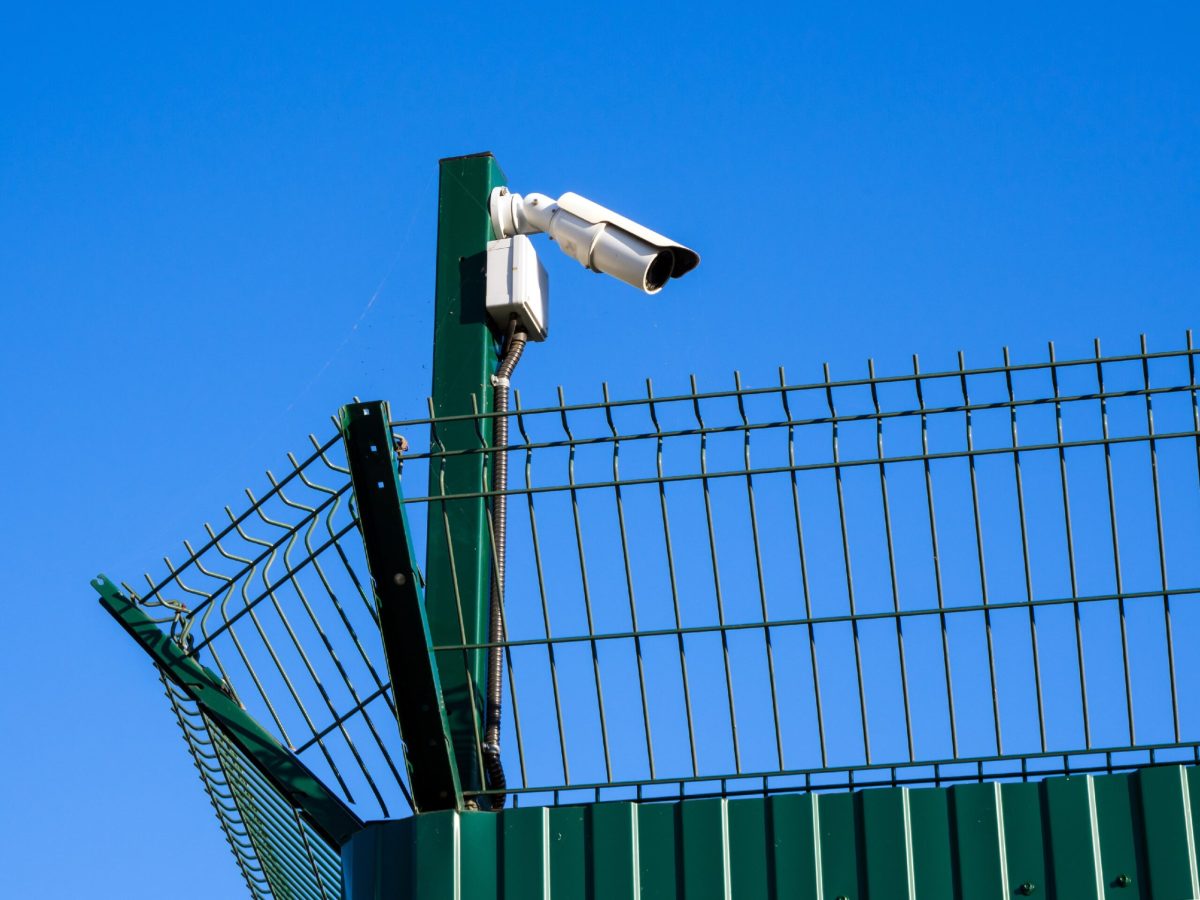Home>Home Security and Surveillance>How Do Perimeter Intrusion Detection Systems Work


Home Security and Surveillance
How Do Perimeter Intrusion Detection Systems Work
Modified: March 6, 2024
Discover how perimeter intrusion detection systems work to enhance home security and surveillance. Uncover the latest innovations in protecting your property with advanced technology.
(Many of the links in this article redirect to a specific reviewed product. Your purchase of these products through affiliate links helps to generate commission for Storables.com, at no extra cost. Learn more)
Introduction
Home security is a top concern for homeowners across the globe. With the increasing prevalence of break-ins and burglaries, it’s important to take every possible measure to protect our homes and loved ones. In recent years, Perimeter Intrusion Detection Systems (PIDS) have emerged as an effective solution to enhance the security of residential properties. These advanced systems offer an added layer of protection by detecting and alerting homeowners to any unauthorized entry or activity around the perimeter of their property.
In this article, we will explore the world of Perimeter Intrusion Detection Systems, delving into their various types, working principles, sensing technologies, and integration with existing security systems. We will also discuss their limitations and highlight successful case studies where these systems have proven their effectiveness in safeguarding homes.
So, let’s dive in and discover how Perimeter Intrusion Detection Systems can provide the peace of mind and security that every homeowner desires.
Key Takeaways:
- Perimeter Intrusion Detection Systems (PIDS) use advanced sensors and alarms to protect homes from unauthorized entry. They work alongside other security measures to provide comprehensive protection and peace of mind.
- PIDS can be integrated with CCTV, access control, and alarm systems to enhance security. While effective, it’s important to consider factors like false alarms, maintenance, and cost when implementing PIDS.
Overview of Perimeter Intrusion Detection Systems
Perimeter Intrusion Detection Systems (PIDS) are designed to detect and deter unauthorized access to a property’s perimeter. They act as a crucial first line of defense, providing an early warning system against potential intruders.
These systems consist of a combination of sensors and alarms strategically placed around the perimeter of a property. When an intrusion is detected, the system alerts the homeowner or security personnel, allowing them to take immediate action.
PIDS utilize advanced technologies to effectively monitor the surroundings and detect any unusual activity. These technologies include infrared sensors, microwave sensors, laser sensors, vibration sensors, and acoustic sensors, among others. These sensors are deployed in a variety of ways, such as buried wires, beams, fences, or walls, depending on the specific requirements of the property.
In addition to detecting unauthorized entry, PIDS can also provide valuable information about the nature of the intrusion. This information can be used to determine the appropriate response and inform law enforcement if necessary.
It’s important to note that Perimeter Intrusion Detection Systems are not meant to replace other security measures like door locks, alarms, or surveillance cameras. Instead, they work in conjunction with these systems to provide comprehensive security coverage.
Now that we have an overview of Perimeter Intrusion Detection Systems, let’s explore the different types of PIDS available.
Types of Perimeter Intrusion Detection Systems
Perimeter Intrusion Detection Systems (PIDS) come in various forms, each with its own set of capabilities and advantages. Here are some common types of PIDS:
- Electric Fence Systems: Electric fence systems are one of the oldest and most widely used types of PIDS. They consist of electrified wires or conductive material installed on fences or walls. When an intruder comes into contact with the electric fence, it delivers a non-lethal electric shock that deters their progress and triggers an alarm.
- Pressure Sensor Systems: This type of PIDS relies on pressure-sensitive sensors that are placed beneath the ground’s surface. When an intruder steps on or applies pressure to the sensor, it triggers an alarm. Pressure sensor systems are commonly used in outdoor areas where traditional fences or walls cannot be installed.
- Beam Systems: Beam systems utilize infrared or laser beams that create an invisible barrier. When an intruder crosses these beams, it disrupts the signal and triggers an alarm. Beam systems are often used in high-security applications as they provide accurate and reliable detection.
- Microwave Systems: Microwave systems emit microwave signals and detect any changes in the pattern caused by an intruder. These systems are highly sensitive and can detect intrusions even in adverse weather conditions like rain, fog, or snow. However, they require careful calibration to avoid false alarms.
- Video Analytics Systems: Video analytics systems utilize advanced video surveillance cameras combined with intelligent software algorithms. The software analyzes video footage in real-time and can identify suspicious activities or intrusions. Video analytics systems can reduce false alarms by distinguishing between normal events and potential threats.
Each type of PIDS has its own strengths and weaknesses, and the choice depends on factors such as the property layout, budget, and specific security requirements.
Now that we have a better understanding of the types of PIDS available, let’s explore how these systems work and detect intrusions.
Working Principles of Perimeter Intrusion Detection Systems
Perimeter Intrusion Detection Systems (PIDS) rely on a variety of working principles to detect intrusions effectively. Understanding these principles can help us grasp the inner workings of these systems. Here are some common working principles of PIDS:
- Sensor-Based Detection: PIDS typically use various types of sensors strategically placed around the perimeter to detect any unauthorized entry. These sensors can include infrared sensors, microwave sensors, vibration sensors, or acoustic sensors. When an intruder crosses the boundary or attempts to breach the perimeter, these sensors detect the change in the environment and trigger an alarm.
- Signal Analysis: Some PIDS utilize advanced signal analysis techniques to detect intrusions. For example, microwave systems analyze the signal patterns and detect any changes caused by an intruder’s presence. Similarly, video analytics systems analyze the video footage in real-time, looking for specific patterns or movements that indicate intrusions.
- Triangulation: Triangulation is often used in laser-based or beam systems. By emitting multiple beams in different directions and angles, these systems can create a virtual net or grid. When an intruder breaks one or more of these beams, the system triangulates the location of the intrusion and triggers an alarm.
- Vibration Analysis: PIDS that use vibration sensors can detect intrusions by analyzing vibrations or disturbances caused by someone climbing or tampering with fences, walls, or other physical barriers. These sensors are highly sensitive and can distinguish between normal environmental vibrations and those caused by unauthorized activities.
- Combined Technologies: In some cases, PIDS combine multiple technologies to increase the effectiveness of intrusion detection. For example, a system might use infrared sensors along with video analytics to provide a more holistic approach to perimeter security.
It’s worth noting that PIDS can be configured to accommodate different sensitivity levels based on the environment and specific security requirements. This helps minimize false alarms while ensuring accurate detection of potential intrusions.
Next, let’s explore the sensing technologies commonly used in Perimeter Intrusion Detection Systems.
Sensing Technologies Used in Perimeter Intrusion Detection Systems
Perimeter Intrusion Detection Systems (PIDS) utilize a range of sensing technologies to detect and alert against unauthorized access. These technologies play a crucial role in accurately identifying intrusions and minimizing false alarms. Here are some commonly used sensing technologies in PIDS:
- Infrared (IR) Sensors: Infrared sensors detect changes in infrared radiation levels. They can be configured to detect body heat or movement. When an intruder enters the monitored area, the sensor detects the change in infrared radiation and triggers an alarm.
- Microwave Sensors: Microwave sensors emit and receive microwave signals. They detect disturbances caused by an intruder crossing the monitored area. These sensors can be fine-tuned to differentiate between different types of disturbances and filter out false alarms caused by animals or environmental factors.
- Vibration Sensors: Vibration sensors detect vibrations or disturbances in physical barriers such as fences, walls, or windows. They can be set to different sensitivity levels to discern between normal vibrations and those caused by unauthorized activities. When an intrusion is detected, the sensor sends a signal to trigger an alarm.
- Acoustic Sensors: Acoustic sensors are designed to pick up sound waves. They are capable of detecting noises like footsteps, breaking glass, or other sounds associated with an intrusion. These sensors can be highly sensitive and can be programmed to disregard normal ambient noise.
- Laser Sensors: Laser sensors use laser beams to create a virtual barrier. When an intruder crosses the laser beam, it interrupts the beam, triggering an alarm. These sensors can detect even slight disruptions and are highly accurate when properly calibrated.
- Pressure Sensors: Pressure sensors are typically installed beneath the ground’s surface. When an intruder steps on or applies pressure to the sensor, it triggers an alarm. These sensors are especially useful in outdoor areas where fences or walls cannot be installed, such as large open spaces.
Choosing the right sensing technology depends on factors such as the property layout, environmental conditions, and the desired level of accuracy. Some PIDS also combine multiple sensing technologies to enhance detection capabilities.
Now that we have explored the sensing technologies used in PIDS, let’s move on to the alarm and notification systems that are an integral part of these security systems.
Tip: Perimeter Intrusion Detection Systems work by using sensors, such as motion detectors or vibration sensors, to detect any unauthorized entry or movement along the perimeter of a secured area. These sensors then trigger an alarm to alert security personnel.
Read more: How To Create Intrusion Detection System
Alarm and Notification Systems
When it comes to Perimeter Intrusion Detection Systems (PIDS), the timely detection of unauthorized access is crucial. Alarm and notification systems play a vital role in alerting homeowners or security personnel so that they can respond promptly to any potential intrusion. Here are the key components of alarm and notification systems in PIDS:
- Alarm Activation: When an intrusion is detected by the sensors or technologies used in the PIDS, the alarm system is activated. This can be in the form of a loud siren, flashing lights, or a combination of both. The purpose of the alarm is to deter the intruder and draw attention to the potential breach of security.
- Centralized Monitoring: PIDS can be connected to a centralized monitoring system, either onsite or offsite. These systems continuously monitor the perimeter and receive alerts when an intrusion is detected. Trained security personnel can then assess the situation and take appropriate action.
- Notification Systems: In addition to activating audible alarms, PIDS can be configured to send notifications to homeowners or security personnel through various communication channels. This can include SMS alerts, email notifications, or mobile app notifications. These notifications provide real-time information about the intrusion, allowing for immediate response and potentially involving law enforcement if necessary.
- Integration with Security Systems: PIDS are often integrated with other security systems, such as CCTV cameras or access control systems. When an intrusion is detected, the PIDS can trigger the recording of video footage from the corresponding cameras, capturing evidence of the intrusion. It can also disable or lock access control systems to prevent further unauthorized entry.
- Remote Access and Control: Advanced PIDS offer remote access and control capabilities, allowing homeowners or security personnel to monitor and control the system from anywhere. Through a secure online interface or mobile app, they can view the status of the PIDS, receive real-time alerts, and even arm or disarm the system remotely.
The alarm and notification systems in PIDS are designed to ensure that any potential intrusions are promptly detected and appropriate action is taken. They provide homeowners and security personnel with the essential information and tools needed to protect the property and its occupants.
Now that we understand the alarm and notification systems, let’s explore the integration of PIDS with existing security systems.
Integration with Security Systems
Perimeter Intrusion Detection Systems (PIDS) can be seamlessly integrated with existing security systems to create a comprehensive and robust security infrastructure. This integration enhances the effectiveness of both the PIDS and the overall security measures. Here are some key aspects of integrating PIDS with other security systems:
- CCTV Surveillance: Integration with closed-circuit television (CCTV) surveillance systems allows for visual monitoring and recording of potential intrusions. When an intrusion is detected by the PIDS, the corresponding CCTV cameras can be triggered to start recording, capturing valuable evidence during the event.
- Access Control Systems: PIDS can be integrated with access control systems to enhance perimeter security. When an intrusion is detected, the PIDS can automatically trigger the locking of doors, gates, or other entry points, preventing unauthorized access to the property.
- Intrusion Alarm Systems: PIDS can work in conjunction with intrusion alarm systems to provide a multi-layered defense against unauthorized access. When an intrusion is detected by the PIDS, it can trigger the activation of the intrusion alarm, sounding sirens, and alerting security personnel.
- Alarm Monitoring Services: PIDS can be connected to alarm monitoring services that provide round-the-clock monitoring and response. When an intrusion is detected, the alarm monitoring service is alerted, and they can dispatch security personnel or inform law enforcement as necessary.
- Mobile Integration: PIDS can integrate with mobile applications, allowing homeowners or security personnel to monitor and control the system from anywhere via smartphones or tablets. This provides convenience and peace of mind, as real-time alerts and system status updates can be accessed on the go.
Integration with other security systems not only enhances the overall security of the property but also improves the efficiency and effectiveness of response measures. The seamless coordination of different security systems allows for a more proactive and comprehensive approach to perimeter security.
Now, let’s discuss the limitations and considerations when implementing Perimeter Intrusion Detection Systems.
Limitations and Considerations
While Perimeter Intrusion Detection Systems (PIDS) are highly effective in enhancing the security of residential properties, it’s important to be aware of their limitations and consider certain factors before implementing them. Here are some limitations and considerations to keep in mind:
- False Alarms: PIDS rely on sensors and technologies that can sometimes trigger false alarms. Factors such as animals, environmental conditions, or even unintentional interference can lead to false alerts. It’s crucial to calibrate and fine-tune the system to minimize false alarms and ensure accurate detection.
- Environmental Factors: Certain environmental conditions, such as heavy rain, fog, or strong winds, can impact the effectiveness of PIDS. It’s important to consider the specific environmental conditions of the property and choose the appropriate sensing technologies that can operate reliably in those conditions.
- System Maintenance: Like any other security system, PIDS require regular maintenance to ensure optimal performance. This includes inspections, testing of sensors, and software updates. Regular maintenance helps identify any issues, reduces false alarms, and ensures that the system is in proper working order to detect potential intrusions.
- Cost Considerations: Implementing a PIDS involves an initial investment in the system, installation, and ongoing maintenance costs. It’s important to assess the budget and weigh the benefits against the expenses. Consider the value of the property, the level of security desired, and consult with security experts to determine the most cost-effective solution.
- Privacy Concerns: PIDS may require the use of video surveillance cameras or other monitoring technologies. It’s essential to address any potential privacy concerns by respecting local privacy laws and ensuring that the system is used responsibly and ethically.
- System Integration: When integrating PIDS with other security systems, compatibility and interoperability should be considered. Ensure that the PIDS can seamlessly communicate and integrate with existing security infrastructure, such as access control systems or CCTV surveillance systems.
By understanding these limitations and considering the relevant factors, homeowners can make informed decisions when choosing and implementing a Perimeter Intrusion Detection System that meets their security needs.
Now, let’s explore some successful case studies to better understand the practical application of PIDS in safeguarding homes.
Case Studies: Successful Implementation of Perimeter Intrusion Detection Systems
Perimeter Intrusion Detection Systems (PIDS) have been successfully implemented in various residential properties, providing effective security solutions and peace of mind for homeowners. Let’s take a look at a couple of case studies that highlight the successful implementation of PIDS:
- Case Study 1: The Johnson Residence
- Case Study 2: The Smith Condominium Complex
The Johnson family resides in a suburban neighborhood where break-ins and property thefts were becoming increasingly frequent. Concerned about the safety of their family and belongings, they decided to invest in a comprehensive security system, including a PIDS. They opted for an electric fence system along with CCTV surveillance integration. The electric fence offered a strong physical deterrent, while the PIDS detected any attempted breach of the perimeter. The CCTV cameras provided visual evidence of any intrusions. Since the installation of the PIDS, the Johnson residence has remained secure, and the system has successfully deterred any potential intruders.
The Smith Condominium Complex experienced a series of security breaches, leading to concerns among residents and management. To address the security challenges, PIDS was implemented throughout the complex. The PIDS included infrared sensors, beam systems, and a centralized monitoring system. The infrared sensors detected any unauthorized movement around the perimeter, and the beam systems created an additional layer of detection. The centralized monitoring system ensured that security personnel were promptly alerted in the event of an intrusion. Since the implementation of the PIDS, the Smith Condominium Complex has witnessed a significant improvement in security and a reduction in security incidents.
These case studies serve as examples of how Perimeter Intrusion Detection Systems can successfully enhance the security of residential properties. By selecting the appropriate PIDS and integrating them with other security measures, homeowners and property management can effectively mitigate security risks and protect their assets.
Now, let’s conclude our exploration of Perimeter Intrusion Detection Systems.
Read more: How To Test Intrusion Detection System
Conclusion
Perimeter Intrusion Detection Systems (PIDS) have become an essential component of residential security, providing homeowners with an enhanced level of protection and peace of mind. These systems, alongside other security measures, act as a crucial first line of defense against unauthorized access and intrusions.
Throughout this article, we have examined the various aspects of PIDS, including their types, working principles, sensing technologies, alarm and notification systems, integration with other security systems, and limitations to consider. We have also explored case studies showcasing the successful implementation of PIDS in safeguarding homes.
By deploying the appropriate PIDS, homeowners can create a robust security infrastructure that deters potential intruders, detects intrusions, and alerts homeowners or security personnel to take immediate action. Integration with other security systems, such as CCTV surveillance and access control, further strengthens the overall security measures.
However, it’s important to bear in mind the limitations and considerations associated with PIDS. False alarms, environmental factors, maintenance requirements, cost considerations, and privacy concerns should all be taken into account when implementing these systems.
In conclusion, Perimeter Intrusion Detection Systems provide an added layer of security for residential properties, helping to keep homes and loved ones safe. Whether through electric fences, beam systems, or other types of PIDS, these advanced security solutions play a vital role in deterring intrusions and offering timely detection. With careful consideration and proper implementation, homeowners can achieve a greater sense of security and protect their most valuable assets.
Thank you for joining us on this journey to explore the world of Perimeter Intrusion Detection Systems. Stay vigilant, stay secure!
Frequently Asked Questions about How Do Perimeter Intrusion Detection Systems Work
Was this page helpful?
At Storables.com, we guarantee accurate and reliable information. Our content, validated by Expert Board Contributors, is crafted following stringent Editorial Policies. We're committed to providing you with well-researched, expert-backed insights for all your informational needs.













